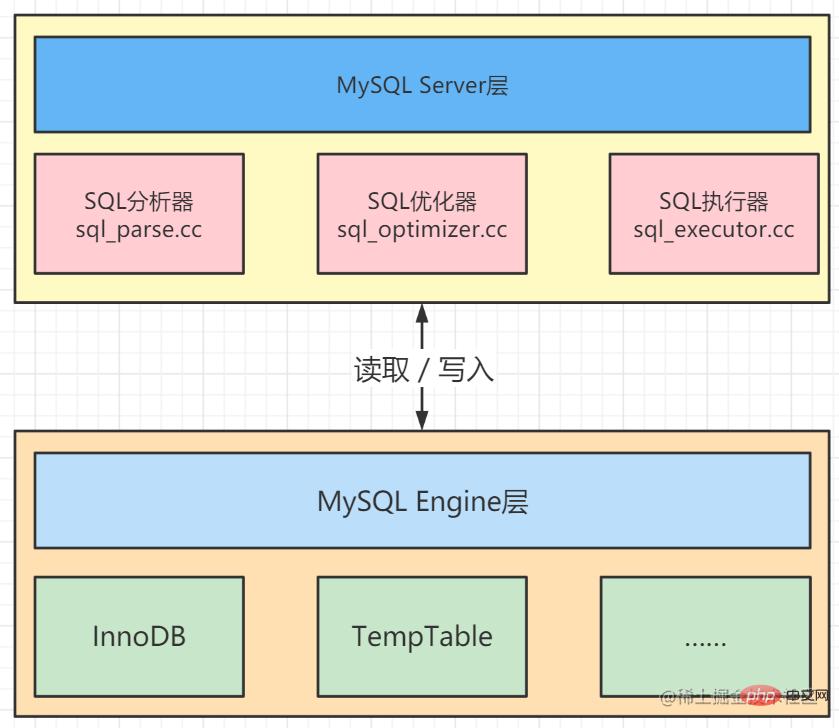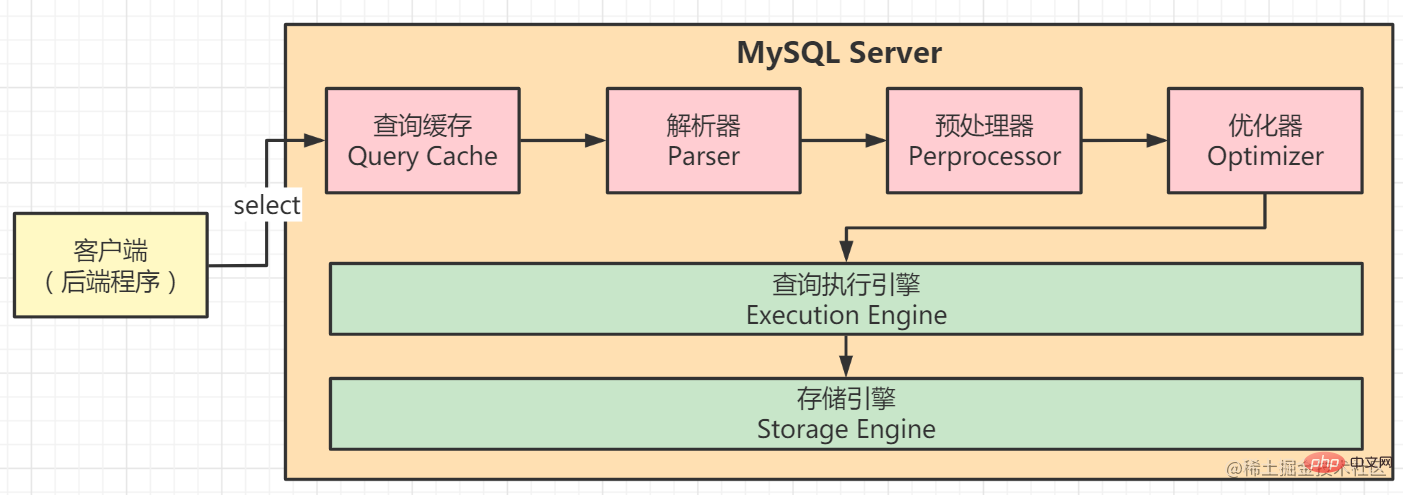Home >Database >Mysql Tutorial >In-depth understanding of how the MySQL index optimizer works
This article brings you relevant knowledge about mysql, which mainly introduces the relevant content about the working principle of the index optimizer, including the composition of MySQL Server, the MySQL optimizer selects indexes Principle and SQL cost analysis, and finally summarize the entire query process through select query. Let’s take a look at it together. I hope it will be helpful to everyone.

Recommended learning: mysql video tutorial
ID) auto-incrementing primary key index, (LOG_ID, SUB_ODR_ID) are set as joint index and unique index, and two indexes are set for CREATE_TIME and UPDATE_TIME respectively.
CREATE TABLE `***` ( `ID` bigint(20) NOT NULL AUTO_INCREMENT COMMENT '主键id', `LOG_ID` varchar(32) NOT NULL COMMENT '交易流水号', `ODR_ID` varchar(32) NOT NULL COMMENT '父单号', `SUB_ODR_ID` varchar(32) NOT NULL COMMENT '子单号', `CREATE_TIME` datetime(0) NOT NULL COMMENT '创建时间', `CREATE_BY` varchar(32) NOT NULL COMMENT ' 创建人', `UPDATE_TIME` datetime(0) NOT NULL DEFAULT CURRENT_TIMESTAMP(0) ON UPDATE CURRENT_TIMESTAMP(0) COMMENT '更新时间', `UPDATE_BY` varchar(32) NOT NULL COMMENT '更新人', PRIMARY KEY (`ID`) USING BTREE, UNIQUE INDEX `UNQ_LOG_SUBODR_ID`(`LOG_ID`, `SUB_ODR_ID`) USING BTREE, INDEX `IDX_ODR_ID`(`ODR_ID`) USING BTREE, INDEX `IDX_SUB_ID`(`SUB_ODR_ID`) USING BTREE, INDEX `IDX_CREATE_TIME`(`CREATE_TIME`) USING BTREE, INDEX `IDX_UPDATE_TIME`(`UPDATE_TIME`) USING BTREE ) ENGINE = InnoDB AUTO_INCREMENT = 1 SET = utf8 COLLATE = utf8_general_ci COMMENT = '分摊业务明细表' ROW_FORMAT = Dynamic;In the query field SUB_ODR_ID, three related indexes can theoretically be used: UNQ_LOG_SUBODR_ID, IDX_SUB_ID. How does the MySQL optimizer choose from these three indexes? In relational databases, B-trees are just data structures used for storage. How to use it depends on the optimizer of the database. The optimizer determines the selection of a specific index, known as the execution plan. Optimizer selection is based on cost, with the lower the cost, the higher the preference index.

Cost = Server Cost + Engine Cost = CPU Cost + IO CostMySQL optimizer believes that if a piece of SQL needs to create a disk-based temporary table, then the cost at this time is the largest, which is 20 times that of a memory-based temporary table. The cost of comparing index key values and records is very low, but if there are many records to be compared, the cost can be very high. The MySQL optimizer believes that the cost of reading from disk is 4 times the cost of memory (the cost is not static and will vary depending on the hardware).
EXPLAIN FORMAT=json select * from test.fork_business_detail f where f.sub_odr_id = ''read_cost represents the cost of reading from the InnoDB storage engine; eval_cost represents the CPU cost of the server layer; prefix_cost represents the total cost of SQL ; data_read_per_join represents the total number of bytes in the read record.
{
"query_block": {
"cost_info": {
"query_cost": "1.20"
},
"table": {
"access_type": "ref",
"possible_keys": [
"IDX_SUB_ID"
],
"key": "IDX_SUB_ID",
"used_key_parts": [
"SUB_ODR_ID"
],
"key_length": "98",
"ref": [
"const"
],
"cost_info": {
"read_cost": "1.00",
"eval_cost": "0.20",
"prefix_cost": "1.20",
"data_read_per_join": "1K"
},
"used_columns": [
"ID",
"LOG_ID",
"ODR_ID",
"SUB_ODR_ID",
"CREATE_TIME",
"CREATE_BY",
"UPDATE_TIME",
"UPDATE_BY"
]
}
}
}

The above is the detailed content of In-depth understanding of how the MySQL index optimizer works. For more information, please follow other related articles on the PHP Chinese website!